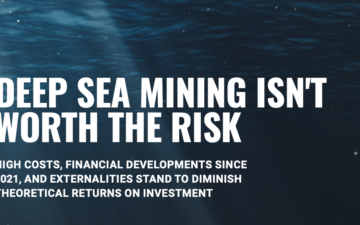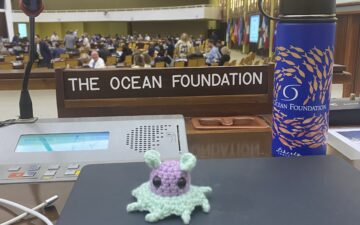Deep Seabed Mining Isn’t Worth The Financial Risk
Press & Social Media Toolkit
Help us spread the word about The Ocean Foundation’s newest report!
Deep Seabed Mining Isn’t Worth The Financial Risk is a new report from The Ocean Foundation that provides the most comprehensive assessment to date of the extent to which the industry is economically viable, revealing unrealistic financial models, technological challenges, and poor market prospects that gravely undermine its potential for profit. The below toolkit features key messages, social media graphics, and other resources to help spread the findings of this new report.
Jump to Sections
With the environmental risks of mining the deep sea already well documented, our new report provides the most comprehensive assessment to date of the extent to which the industry is economically viable, revealing its unrealistic financial models, technological challenges and poor market prospects that gravely undermine its potential for profit. Help us get the word out by sharing this content on your social media platforms!
Key Messages and Takeaways from the Report
Unrealistically optimistic financial models ignore major technical difficulties in extraction at unprecedented depths below the surface, a volatile metals market, and macroeconomic trends.
Seabed minerals are not, as mining companies quip, “a battery in a rock”.
Innovation design for the energy transition, including batteries, is moving away from minerals found on the seabed. In tandem with the growing circular economy, this will likely render DSM unnecessary.
Potential Costs and Liabilities are exacerbated by known and unknown threats in all aspects of DSM, making return on investment uncertain. These threats take the form of:
Front runner company The Metals Company (TMC) has not factored risk or actual damages from environmental spills nor protests (with their attendant costs and liabilities), giving potential investors and decision-makers, an incomplete picture.
International pressure is building to halt DSM: the decision-making body of the International Seabed Authority has said there should be no DSM without regulations; major companies, Indigenous people, civil society, and scientists are calling for a moratorium; and banks, financial institutions, and insurers are rejecting investment in DSM.
Hashtags/Accounts
#DSMisNotWorthTheRisk
#DSMFlawedFinance
#DivestDSM
#DefendTheDeep
The Ocean Foundation
Social Media Posts & Graphics
Square Graphics 1080×1080 (best for Instagram, Facebook, X, and Threads):
If you have trouble downloading the images on mobile, please click HERE.
Landscape Rectangular Graphics 940×788 (best for LinkedIn and Facebook):
If you have trouble downloading the images on mobile, please click HERE.
Portrait Rectangular Graphics 1080×1920 (best for Instagram Stories, or pair with music for TikTok or Reels!):
If you have trouble downloading the images on mobile, please click HERE.
Short, best for X & Threads:
Check out the newest @oceanfdn report: Deep Seabed Mining Isn’t Worth The Financial Risk: https://bit.ly/4bPvySp
#DSMisNotWorthTheRisk #DSMFlawedFinance #DivestDSM #DefendTheDeep
Check out @oceanfdn’s latest report: Deep Seabed Mining Isn’t Worth The Financial Risk. Dive in to uncover the unrealistic financial models, technological challenges, and poor market prospects that make DSM economically unviable. #DefendtheDeep https://bit.ly/4bPvySp
Long, best for Instagram, LinkedIn, Facebook:
Check out the newest The Ocean Foundation report!
Deep Seabed Mining Isn’t Worth The Financial Risk is a new report that provides the most comprehensive assessment to date of the extent to which the industry is economically viable, revealing:
– unrealistic financial models,
– underappreciated technological challenges and
– poor market prospects that gravely undermine its potential for profit.
At the same time, innovation is leading industry toward rapidly emerging alternatives to minerals found on the seabed via
– Better batteries that don’t use minerals from the seabed, and
– The promises of a circular economy.
Our conclusion? We agree with 24 countries, 39 corporations, and thousands of Indigenous leaders and civil society voices to #DefendtheDeep and that #DSMisNotWorthTheRisk
https://oceanfdn.org/wp-content/uploads/2024/02/dsm-finance-brief-2024.pdf
Don’t forget to @ tag us!
Press/Contacts
Check out our press release for more information!
https://oceanfdn.org/new-analysis-business-case-for-deep-sea-mining/
Thanks for helping us share the word that #DSMisNotWorthTheRisk!
PRESS
Kate Killerlain Morrison
External Relations Director
[email protected]
202-318-3178
Deep Seabed Mining
Bobbi-Jo Dobush
Legal Officer
bdob[email protected]
social media
Eva Lukonits
Social Media Manager
eluk[email protected]
Learn More
Recent
New Analysis: Business Case for Deep Sea Mining – Highly Complicated and Widely Unproven – Doesn’t Add Up
Report finds extracting nodules lodged in the ocean floor is rife with technical challenges and overlooks rise of innovations that would eliminate need for deep-seabed mining; warns investors to think …




































